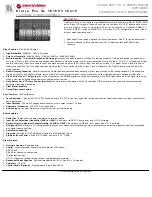
BigIron RX Series Configuration Guide
589
53-1001810-01
PIM dense
23
PIM was introduced to simplify some of the complexity of the routing protocol at the cost of
additional overhead tied with a greater replication of forwarded multicast packets. PIM is similar to
DVMRP in that PIM builds source-routed multicast delivery trees and employs reverse path check
when forwarding multicast packets.
There are two modes in which PIM operates: Dense and Sparse. The Dense Mode is suitable for
densely populated multicast groups, primarily in the LAN environment. The Sparse Mode is suitable
for sparsely populated multicast groups with the focus on WAN.
PIM primarily differs from DVMRP by using the IP routing table instead of maintaining its own,
thereby being routing protocol independent.
Initiating PIM multicasts on a network
Once PIM is enabled on each router, a network user can begin a video conference multicast from
the server on R1 as shown in
Figure 89
. When a multicast packet is received on a PIM-capable
router interface, the interface checks its IP routing table to determine whether the interface that
received the message provides the shortest path back to the source. If the interface does provide
the shortest path back to the source, the multicast packet is then forwarded to all neighboring PIM
routers. Otherwise, the multicast packet is discarded and a prune message is sent back upstream.
In
Figure 89
, the root node (R1) is forwarding multicast packets for group 229.225.0.1, which it
receives from the server, to its downstream nodes, R2, R3, and R4. Router R4 is an intermediate
router with R5 and R6 as its downstream routers. Because R5 and R6 have no downstream
interfaces, they are leaf nodes. The receivers in this example are those workstations that are
resident on routers R2, R3, and R6.
Pruning a multicast tree
As multicast packets reach these leaf routers, the routers check their IGMP databases for the
group. If the group is not in a router’s IGMP database, the router discards the packet and sends a
prune message to the upstream router. The router that discarded the packet also maintains the
prune state for the source, group (S,G) pair. The branch is then pruned (removed) from the
multicast tree. No further multicast packets for that specific (S,G) pair will be received from that
upstream router until the prune state expires. You can configure the PIM Prune Timer (the length of
time that a prune state is considered valid).
For example, in
Figure 89
the sender with address 207.95.5.1 is sending multicast packets to the
group 229.225.0.1. If a PIM router receives any groups other than that group, the router discards
the group and sends a prune message to the upstream PIM router.
In
Figure 90
, Router R5 is a leaf node with no group members in its IGMP database. Therefore, the
router must be pruned from the multicast tree. R5 sends a prune message upstream to its
neighbor router R4 to remove itself from the multicast delivery tree and install a prune state, as
seen in
Figure 90
. Router 5 will not receive any further multicast traffic until the prune age interval
expires.
Summary of Contents for Brocade DCX
Page 40: ...xl BigIron RX Series Configuration Guide 53 1001810 01 ...
Page 72: ...lxxii BigIron RX Series Configuration Guide 53 1001810 01 ...
Page 88: ...16 BigIron RX Series Configuration Guide 53 1001810 01 Searching and filtering output 1 ...
Page 300: ...228 BigIron RX Series Configuration Guide 53 1001810 01 Displaying IP information 7 ...
Page 318: ...246 BigIron RX Series Configuration Guide 53 1001810 01 Deploying a LAG 8 ...
Page 418: ...346 BigIron RX Series Configuration Guide 53 1001810 01 SuperSpan 12 ...
Page 482: ...410 BigIron RX Series Configuration Guide 53 1001810 01 MRP CLI example 14 ...
Page 506: ...434 BigIron RX Series Configuration Guide 53 1001810 01 Displaying VSRP information 15 ...
Page 582: ...510 BigIron RX Series Configuration Guide 53 1001810 01 Viewing Layer 2 ACLs 20 ...
Page 634: ...562 BigIron RX Series Configuration Guide 53 1001810 01 Troubleshooting ACLs 21 ...
Page 642: ...570 BigIron RX Series Configuration Guide 53 1001810 01 Trunk formation 22 ...
Page 746: ...674 BigIron RX Series Configuration Guide 53 1001810 01 Displaying RIP filters 24 ...
Page 808: ...736 BigIron RX Series Configuration Guide 53 1001810 01 Displaying OSPF information 25 ...
Page 938: ...866 BigIron RX Series Configuration Guide 53 1001810 01 Displaying MBGP information 27 ...
Page 950: ...878 BigIron RX Series Configuration Guide 53 1001810 01 Using secure copy 28 ...
Page 988: ...916 BigIron RX Series Configuration Guide 53 1001810 01 Clearing IS IS information 29 ...
Page 1054: ...982 BigIron RX Series Configuration Guide 53 1001810 01 Sample 802 1x configurations 33 ...
Page 1108: ...1036 BigIron RX Series Configuration Guide 53 1001810 01 sFlow 39 ...
Page 1190: ...1118 BigIron RX Series Configuration Guide 53 1001810 01 Displaying RIPng information 44 ...
Page 1270: ...1198 BigIron RX Series Configuration Guide 53 1001810 01 Displaying ACLs 47 ...
Page 1310: ...1238 BigIron RX Series Configuration Guide 53 1001810 01 Displaying OSPFv3 information 48 ...
Page 1382: ...1310 BigIron RX Series Configuration Guide 53 1001810 01 Commands That Require a Reload D ...
Page 1435: ...BigIron RX Series Configuration Guide 1363 53 1001810 01 VSRP E ...
Page 1436: ...1364 BigIron RX Series Configuration Guide 53 1001810 01 VSRP E ...
















































